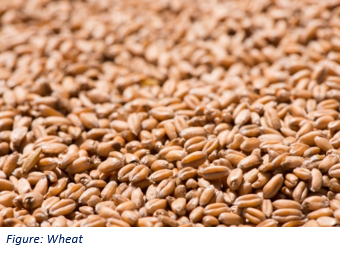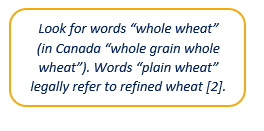WHEAT (Triticum aestivum; Triticum turgidum)
Wheat is the third most produced grain after corn and rice[1]. There are two main varieties of wheat which are widely eaten: bread wheat (Triticum aestivum vulgare) and durum wheat (Triticum turgidum durum).Bread wheat is used for most wheat products and is described as “hard” or “soft” (depends on its protein content) and as “winter” or “spring” (depends on when it is sown) and as “red” or “white” (depend on color of the kernels). Hard wheat contains more protein (including gluten) in comparison to soft wheat. Winter wheat is planted at southern areas and spring wheat is planted at northern areas. Red wheat contains more strong flavored tannins than white wheat [2].
Durum wheat is a hard wheat, which is high in protein and is commonly used for pasta and couscous [3].

Wheat is an important source of protein, dietary fiber, minerals (manganese, phosphorus) and B vitamins (niacin (vitamin B3) and other). Wheat also contains carotenoids (lutein and zeaxanthin) [4]. Wheat has a large amount of gluten (stretchy protein) which on one hand enables bakers to create risen breads, but on the other hand wheat it is not suitable for gluten-intolerant people because of the gluten [2].
HOW TO BE CERTAIN YOU'RE GETTING WHOLE WHEAT?

References:
1. Oldways whole grains council. Wheat July grain of the month
2. Oldways whole grains council. Whole grains a to z
3. Oldways whole grains council. Wheat photo gallery
4. Kumar, P., Yadava, RK., Gollen, B., Kumar,S., Yerma, RK., Yadav, S. (2011). Nutritional Contents and Medicinal Properties of Wheat: A Review